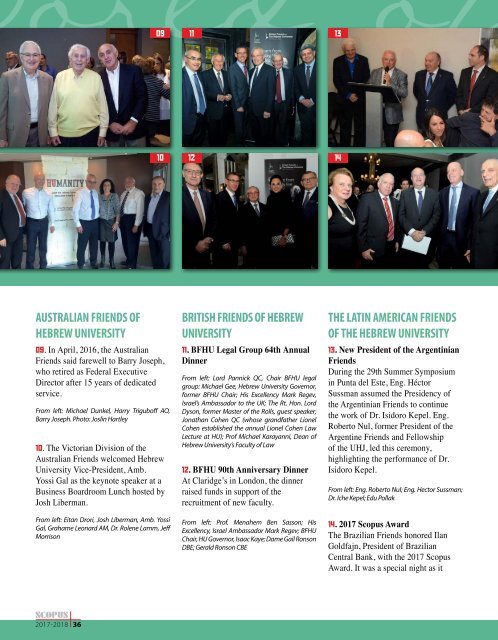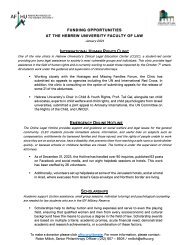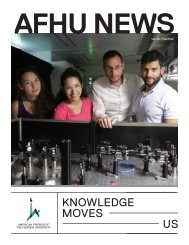You also want an ePaper? Increase the reach of your titles
YUMPU automatically turns print PDFs into web optimized ePapers that Google loves.
it means to sit in a tank for hours at<br />
a time before they actually develop<br />
technology for that tank,” explains<br />
T who spent four and a half years<br />
working on classified projects with the<br />
Ministry of Defense after he graduated<br />
Talpiot.<br />
The recruitment process for Talpiot<br />
is legendary and widely acknowledged<br />
to be one of the cornerstones of its<br />
success. The application pool starts<br />
with 10,000 of the top high school test<br />
scorers. Based on their high school<br />
grades as well, 3,000 are invited to<br />
attend a full day of testing covering<br />
physics, math, common knowledge<br />
and even creative physics. The 200<br />
candidates with the highest scores<br />
from these exams are then required to<br />
attend a two-day series of exercises<br />
which examine their character, team<br />
building and leadership skills. “We<br />
need people who can make a difference<br />
in a short amount of time and who<br />
have the ability to work well in a<br />
team,” explains T. “Not only must they<br />
understand what the right thing is to<br />
do, they must also be able to convince<br />
the people around them—many of<br />
whom might be senior to them, which<br />
is much harder to do.” Ultimately, only<br />
an average of 50 candidates will be<br />
accepted into a new class.<br />
Those who are accepted into the<br />
program embark on a three-year<br />
program, pushing them to intellectual<br />
heights, constantly taking measure<br />
of their character and reinforcing<br />
values consistent with an IDF officer.<br />
Cadets graduate with a Bsc and the<br />
rank of First Lieutenant, and are then<br />
integrated into top R&D positions<br />
within the IDF and Israel’s military<br />
industries. Obligated for at least six<br />
years, they will develop and work on<br />
Israel’s most advanced technologies<br />
ranging from cybersecurity, detection<br />
of enemy tunnels into Israel, as well as<br />
the revolutionary Iron Dome missile<br />
defense system.<br />
ELAD WALACH: A TALPIOT ALUMNUS<br />
BRINGS ARTIFICIAL INTELLIGENCE TO<br />
MEDICAL IMAGING ANALYSIS<br />
Talpiot graduates are some of the<br />
most highly trained innovators<br />
in Israel, and they often bring<br />
their skills to the hi-tech industry after<br />
their service honing Israeli military<br />
technology officially ends.<br />
Elad Walach graduated Talpiot<br />
in 2009 with a Bsc in Computer<br />
Science and spent the next six years<br />
developing algorithms for the Israeli<br />
Air Force. After returning to serve<br />
as the class commander of Talpiot,<br />
he and two of his fellow graduates,<br />
Michael Braginsky and Guy Reiner<br />
founded a startup, Aidoc, to help<br />
radiologists analyze complex medical<br />
scans and improve their workflow<br />
processes.<br />
Using technology rooted in Artificial<br />
Intelligence, Aidoc’s product spots<br />
and highlights visual abnormalities<br />
in medical imaging scans for<br />
radiologists who today must contend<br />
with a proliferation of CTs and MRIs,<br />
which have more than doubled their<br />
workload.<br />
“A scan contains hundreds of images<br />
Talpiot alumni and Aidoc Founders:<br />
Michael Braginsky, Elad Walach and Guy Reiner<br />
and a full body scan could contain<br />
over 2,000 images,” Walach explains.<br />
“Looking through these scans can take<br />
quite a bit of time, and there is only<br />
so much today’s radiologists who are<br />
under increasing demands can do with<br />
the manual tools at their disposal.”<br />
Walach and his co-founders employed<br />
a newly developed tool known<br />
as deep learning “to train” Aidoc<br />
technology to review scans the way a<br />
radiologist would. “We collected data<br />
on 10,000 different medical scans<br />
to create a system that can identify<br />
high-level visual abnormalities and<br />
give the physician a preview of what<br />
is most relevant for interpretation,”<br />
explains Walach.<br />
It is not by chance that Walach and<br />
his fellow graduates chose to focus<br />
on the medical industry. “One of<br />
the fundamental lessons we learned<br />
in Talpiot was the importance of<br />
doing something beyond ourselves,”<br />
he notes. “This was a key factor in<br />
choosing to move forward with this<br />
technology over other options.”<br />
<strong>2017</strong>-2018 19

















